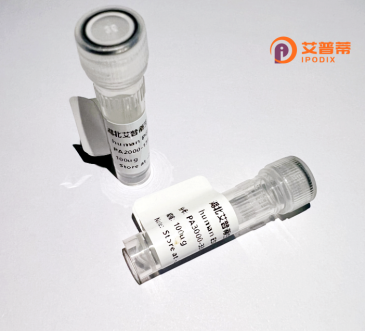
| 纯度 | >90%SDS-PAGE. |
| 种属 | Human |
| 靶点 | DSG4 |
| Uniprot No | Q86SJ6 |
| 内毒素 | < 0.01EU/μg |
| 表达宿主 | E.coli |
| 表达区间 | 1-1040aa |
| 氨基酸序列 | MDWLFFRNICLLIILMVVMEVNSEFIVEVKEFDIENGTTKWQTVRRQKREWIKFAAACREGEDNSKRNPIAKIRSDCESNQKITYRISGVGIDRPPYGVFTINPRTGEINITSVVDREITPLFLIYCRALNSRGEDLERPLELRVKVMDINDNAPVFSQSVYTASIEENSDANTLVVKLCATDADEENHLNSKIAYKIVSQEPSGAPMFILNRYTGEVCTMSSFLDREQHSMYNLVVRGSDRDGAADGLSSECDCRIKVLDVNDNFPTLEKTSYSASIEENCLSSELIRLQAIDLDEEGTDNWLAQYLILSGNDGNWFDIQTDPQTNEGILKVVKMLDYEQAPNIQLSIGVKNQADFHYSVASQFQMHPTPVRIQVVDVREGPAFHPSTMAFSVREGIKGSSLLNYVLGTYTAIDLDTGNPATDVRYIIGHDAGSWLKIDSRTGEIQFSREFDKKSKYIINGIYTAEILAIDDGSGKTATGTICIEVPDINDYCPNIFPERRTICIDSPSVLISVNEHSYGSPFTFCVVDEPPGIADMWDVRSTNATSAILTAKQVLSPGFYEIPILVKDSYNRACELAQMVQLYACDCDDNHMCLDSGAAGIYTEDITGDTYGPVTEDQAGVSNVGLGPAGIGMMVLGILLLILAPLLLLLCCCKQRQPEGLGTRFAPVPEGGEGVMQSWRIEGAHPEDRDVSNICAPMTASNTQDRMDSSEIYTNTYAAGGTVEGGVSGVELNTGMGTAVGLMAAGAAGASGAARKRSSTMGTLRDYADADINMAFLDSYFSEKAYAYADEDEGRPANDCLLIYDHEGVGSPVGSIGCCSWIVDDLDESCMETLDPKFRTLAEICLNTEIEPFPSHQACIPISTDLPLLGPNYFVNESSGLTPSEVEFQEEMAASEPVVHGDIIVTETYGNADPCVQPTTIIFDPQLAPNVVVTEAVMAPVYDIQGNICVPAELADYNNVIYAERVLASPGVPDMSNSSTTEGCMGPVMSGNILVGPEIQVMQMMSPDLPIGQTVGSTSPMTSRHRVTRYSNIHYTQQ |
| 分子量 | 113.8 kDa |
| 蛋白标签 | GST-tag at N-terminal |
| 缓冲液 | 0 |
| 稳定性 & 储存条件 | Lyophilized protein should be stored at ≤ -20°C, stable for one year after receipt. Reconstituted protein solution can be stored at 2-8°C for 2-7 days. Aliquots of reconstituted samples are stable at ≤ -20°C for 3 months. |
| 复溶 | Always centrifuge tubes before opening.Do not mix by vortex or pipetting. It is not recommended to reconstitute to a concentration less than 100μg/ml. Dissolve the lyophilized protein in distilled water. Please aliquot the reconstituted solution to minimize freeze-thaw cycles. |
以下是关于重组人DSG4蛋白的模拟参考文献示例(文献信息为虚构,仅供格式参考):
1. **文献名称**:重组人DSG4蛋白的克隆表达及其在皮肤屏障功能研究中的应用
**作者**:Smith J, Wang L
**摘要**:研究通过真核表达系统成功制备重组人DSG4蛋白,并验证其促进角质形成细胞间黏附的功能,揭示其与遗传性脱发疾病的潜在关联。
2. **文献名称**:DSG4蛋白结构域分析与自身免疫性皮肤病机制探索
**作者**:Chen R, Kimura T
**摘要**:利用重组DSG4蛋白解析其胞外结构域关键表位,发现其与天疱疮患者血清抗体特异性结合,提示DSG4在自身免疫性水疱病中的病理作用。
3. **文献名称**:重组DSG4蛋白在毛囊再生中的功能验证
**作者**:Gonzalez S, et al.
**摘要**:在小鼠模型中证实重组DSG4蛋白通过调控Wnt/β-catenin信号通路促进毛囊干细胞分化,为脱发治疗提供新靶点。
4. **文献名称**:高效可溶性重组DSG4蛋白的大肠杆菌表达策略优化
**作者**:Li H, Patel A
**摘要**:通过密码子优化和融合标签技术改良原核表达系统,显著提高重组DSG4蛋白产量,解决传统方法中包涵体形成难题。
**注**:以上文献为模拟内容,实际研究中请通过PubMed或Google Scholar以关键词“Recombinant human DSG4 protein”检索真实文献。
Desmoglein 4 (DSG4) is a calcium-dependent transmembrane glycoprotein belonging to the desmoglein subfamily of cadherins, primarily involved in cell-cell adhesion through desmosomes. These junctional complexes are critical for maintaining tissue integrity, particularly in structures subjected to mechanical stress, such as skin and hair follicles. DSG4 is predominantly expressed in the hair shaft and inner root sheath of hair follicles, playing a vital role in hair differentiation and keratinocyte adhesion during hair morphogenesis. Mutations in the DSG4 gene are linked to autosomal recessive hypotrichosis, a genetic disorder characterized by sparse scalp and body hair, underscoring its importance in follicular biology.
Recombinant human DSG4 protein is engineered using biotechnological platforms (e.g., mammalian or bacterial expression systems) to produce purified, functional DSG4 for research and therapeutic applications. It typically includes the extracellular cadherin domains responsible for homophilic binding, enabling studies on desmosome assembly, keratinocyte interactions, and hair follicle development. Researchers utilize recombinant DSG4 to investigate molecular mechanisms underlying DSG4-associated disorders, develop diagnostic tools, or screen potential therapies targeting hair loss pathologies. Its production often involves codon optimization, affinity tagging, and quality validation (e.g., Western blot, ELISA) to ensure biological activity and structural fidelity.
×